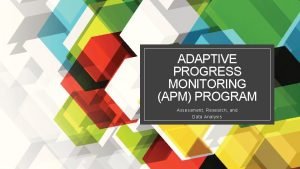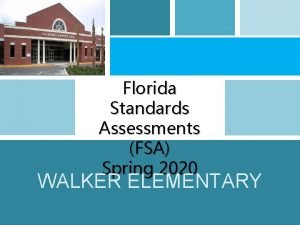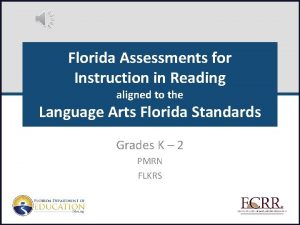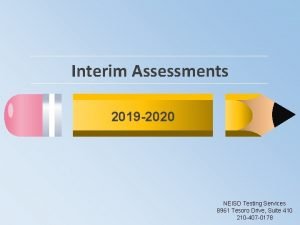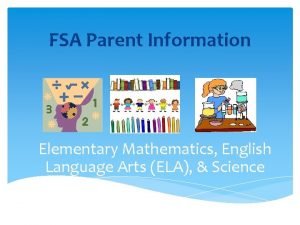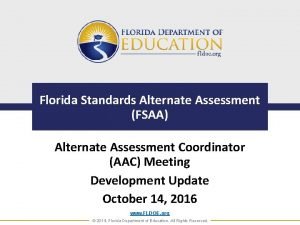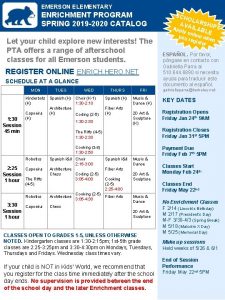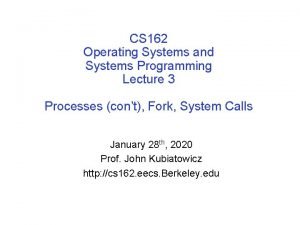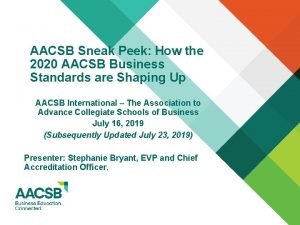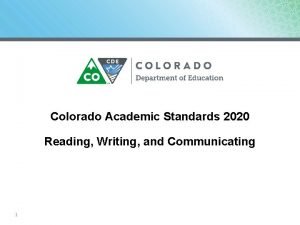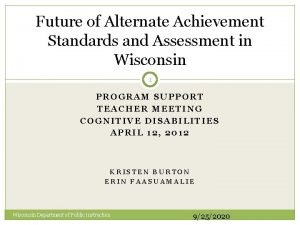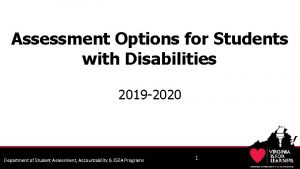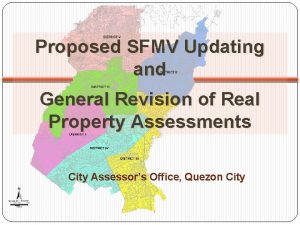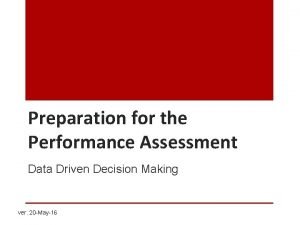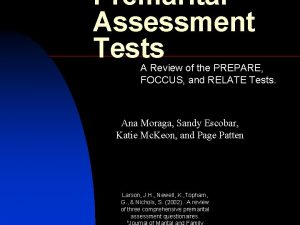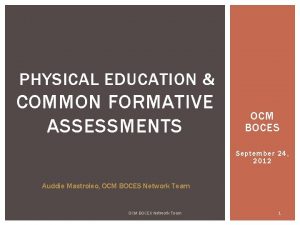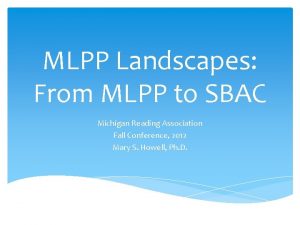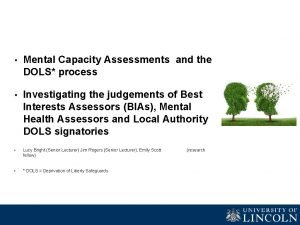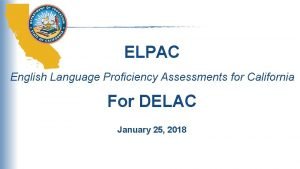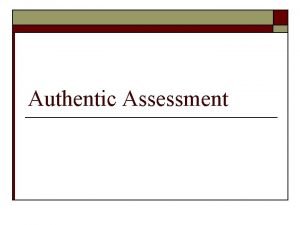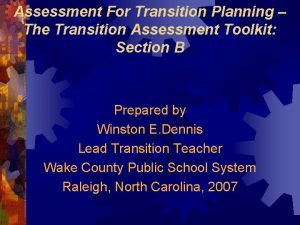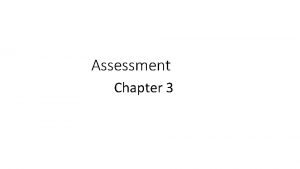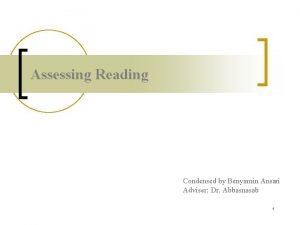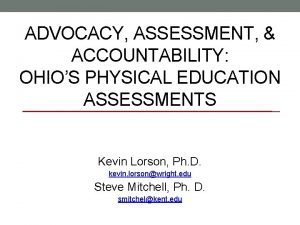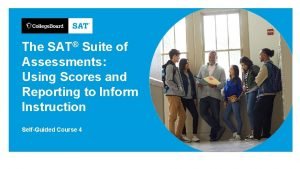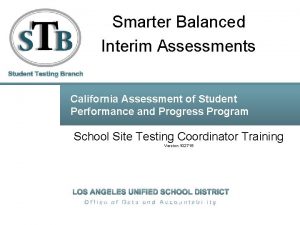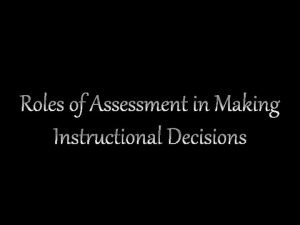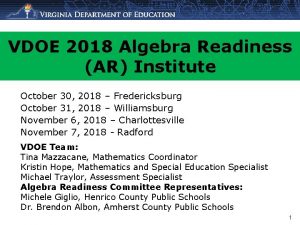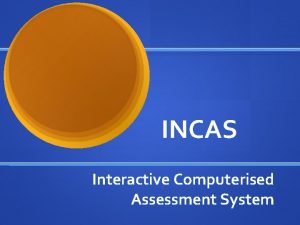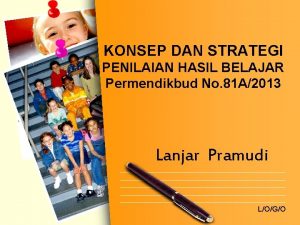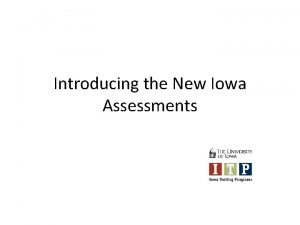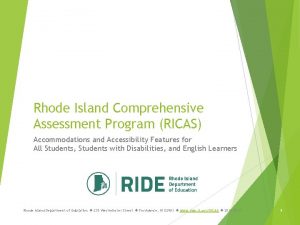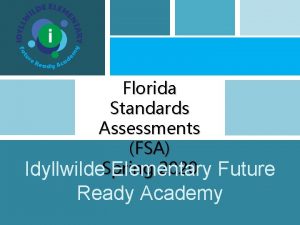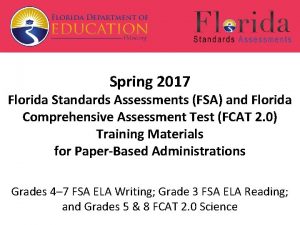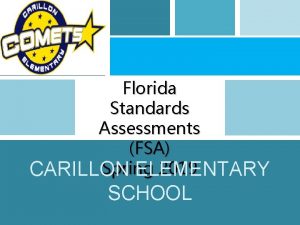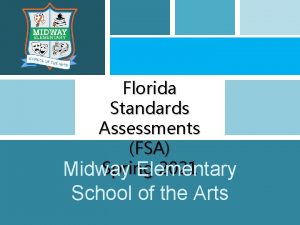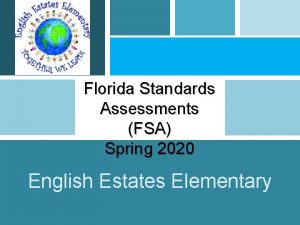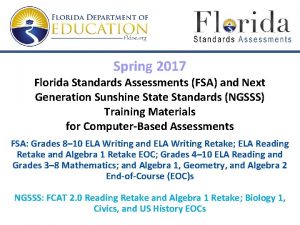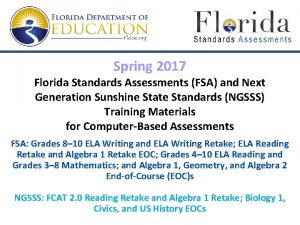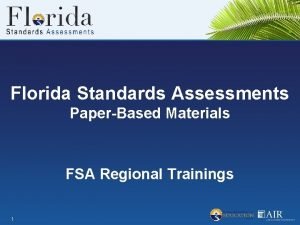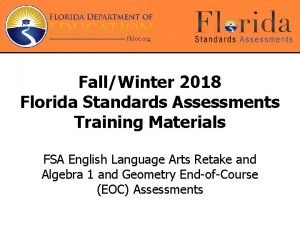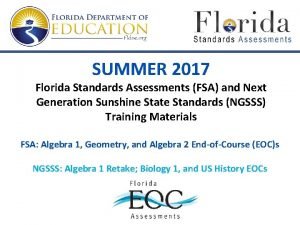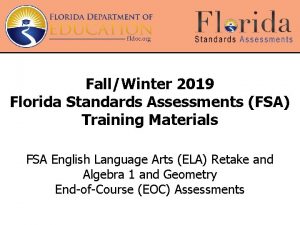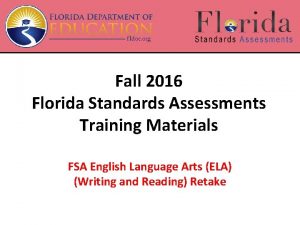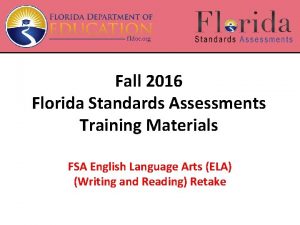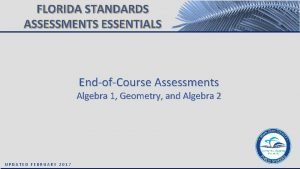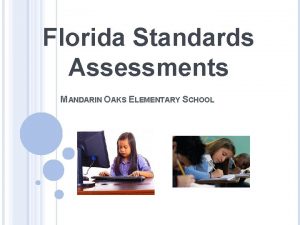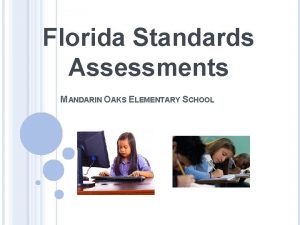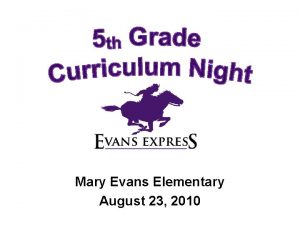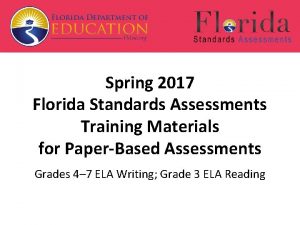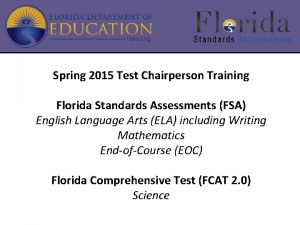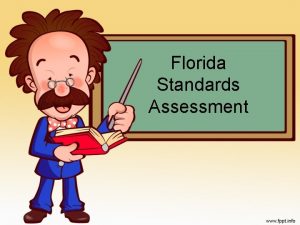Florida Standards Assessments FSA Spring 2020 Evans Elementary






















































- Slides: 54

Florida Standards Assessments (FSA) Spring 2020 Evans Elementary School

Agenda • What are the Florida Standards Assessments? – – – Subjects and Grades Assessed Test Schedule Test Timing Test Design and Test Item Types State Science Assessment Score Information • How are FSA results used? • Helpful Resources

What are the Florida Standards? • The Florida Standards were adopted in 2014 in English/Language Arts and Mathematics to help prepare Florida students for success in college, career, and in life by emphasizing analytical thinking skills. • The Florida Standards Assessments provides a more authentic assessment of the Florida Standards because they include multiple choice, create graphs, interact with test content, and write and respond in different ways than required on traditional tests. • Question types will assess students' higher-order thinking skills in keeping with the higher expectations of the Florida Standards.

Who participates? • Per Florida Statute 1008. 22, all public school students are required to participate in the statewide assessment program. – Accommodations may be provided to students with a current Individual Education Plan (IEP) or Section 504 Plan. • Types of accommodations include: – – – Flexible Presentation Flexible Responding Flexible Scheduling Flexible Setting Assistive Devices & Tools Large Print, One-Item-Per-Page, Braille

What subjects and grades are tested? ALL TESTS WILL BE PAPER-BASED!! • Grades 3 -5 FSA English Language Arts (ELA) • Grades 4 -5 FSA Writing – A student must take both the Writing and Reading tests to receive an FSA ELA score. • Grades 3 -5 FSA Mathematics • Grade 5 Statewide Science

What are the test windows? Assessment Grade Level Test Date(s) FSA Writing Grades 4 and 5 April 1 (Wednesday) Make-ups: April 2 -14 Make-ups: May 11 -15 FSA ELA Grade 3 April 1 & 2 (Wednesday & Thursday) Make-ups: April 3 -14 FSA ELA Grades 4 and 5 May 5 & 6 (Tuesday & Wednesday) Make-ups: May 7 -15 FSA Math Grades 3 -5 May 7 & 8 (Thursday & Friday) Make-ups: May 11 -15 State Science Grade 5 May 12 & 13 (Tuesday & Wednesday) Make-ups: May 14 -22

Are the tests timed? YES! • FSA Writing – Grades 4 and 5 – 120 minutes (1 session) – A 3 -minute break after 60 minutes of testing • FSA ELA – Grades 3, 4, and 5 FSA Mathematics – Grades 3, 4, and 5 Statewide Science – Grade 5 – 160 minutes over two days • 80 minutes – Day 1 • 80 minutes – Day 2 – A short break is given after 40 minutes of testing

Paper-based Test Materials • Grade 3 -5 ELA & Mathematics – Students will receive a Test and Answer Book – Students will work problems in their test and answer book • Grades 4 and 5 Writing – Students will receive a Writing Planning Sheet and a Test and Answer Book • Grade 5 Science – Students will receive a Test Book and an Answer Book/Sheet • Practice Tests have been developed by DOE. Students will have an opportunity to take the practice test at the school prior to the actual test. – Available on the FSA portal for public access. Go to fsassessments. org > Practice Tests

Test Design – ELA (Reading & Writing) ELA-READING CONTENT CATEGORIES Grades 3 -5 Approximate percentage of raw score points for each category. ELA PERCENTAGE OF POINTS BY DEPTH OF KNOWLEDGE (DOK)* LEVEL Grades 3 -5 Reading Text Types Literature - 50% Informational - 50% DOK Level 1 (Low) 10 -20% Key Ideas and Details 15 -25% DOK Level 2 (Mod) 60 -80% Craft and Structure 25 -35% DOK Level 3 (High) 10 -20% Integration of Knowledge and Ideas 20 -30% Note: Text-based Writing (G 4 -5) component is a DOK Level 3 task. Language and Editing 15 -25% Text-Based Writing (Grades 4 -5) Determined each year Total Number of Items 56 -60 *DOK refers to the complexity level of the cognitive process demanded by a test item rather than the difficulty of the item. Level 1: Recall and Reproduction, Level 2: Skills and Concepts, and Level 3: Strategic Thinking Approximately 6 -10 items within the Reading and Language components listed above are field test items are included in the ranges above but are not included in the students’ score.

Test Design - Reading • Two types of Reading passages: – Informational: provide readers with facts about a particular subject and may include magazine and newspaper articles, editorials, and biographies – Literary: written primarily for reader’s enjoyment and may include short stories, poems, folk tales, and selections from novels – Students are also asked to evaluate and correct grade-level errors in a “draft” essay • Approximate Word Count Range for Text Set – Grade 3: 100 -700 – Grade 4: 100 -900 – Grade 5: 200 -1000

Test Design - Writing • FSA Writing (Grades 4 and 5) – Writing component consists of one text-based constructedresponse item • Students read a variety of texts and respond to a prompt – Prompt will ask for the student’s opinion or ask the student to inform/explain • Students will draw upon the texts to provide evidence and information to support their claims or explanations – Writing Score (10 raw score points) – there are 3 domains: • Purpose, Focus, and Organization (4 points) • Evidence and Elaboration (4 points) • Conventions and Standard English (2 points) https: //fsassessments. org/core/fileparse. php/3031/urlt/Opinionl. Rubric 4 -5_Final 1. pdf https: //fsassessments. org/core/fileparse. php/3031/urlt/0015122 -Informational. Rubric 4 -5_Final 1. pdf

Writing Passage & Prompt

Planning Sheet

Writing Rubric and Sample

Writing Testing Tips 1. Read the prompt and determine whether it is asking for information/explanation, or an opinion/argument 2. Read the texts, looking for details to support information or opinion/argument 3. Use the Planning Sheet to organize thoughts and details 4. Write and edit response. Make sure it contains: • • • Clearly stated and strongly maintained idea or argument Details from the passages to support idea or argument Variety of sentence types and transitional strategies Clear and effective expression and logical progression of ideas Strong introduction and conclusion Correct spelling and punctuation

Test Item Types - ELA • ELA Item Types – – – – Multiple Choice Editing Task Selectable Text Multi-Select Evidence-Based Selected Response Table Match Multimedia

Test Item Types - ELA • Multiple Choice – Students select one correct answer from four answer choices.

Test Item Types - ELA • Multiple Choice

Test Item Types - ELA • Editing Task – Students read a short passage with underlined words/phrases. – Students select the correct word/phrase that should replace the underlined word/phrase from a set of options.

Test Item Types - ELA • Selectable Text – Excerpted sentences from the text are presented in two parts. Part A might ask the student to make an analysis or an inference & Part B might require the student to select the text to support the answer in Part A.

Test Item Types - ELA • Multi-Select – Students are directed to select a specific number of correct answers from among the options provided.

Test Item Types - ELA • Evidence-Based Selected Response – Two-part item: Part A is multiple-choice & Part B may be either multiple-choice or multiselect OR Part A asks to make an analysis or inference & Part B requires the student to use the text to support the answer in Part A.

Test Item Types - ELA • Table Match – Presents options in columns and rows. Options may include words, phrases, sentence, quotations, line/paragraph/passage numbers, or images. – Student is directed to select a box that matches a correct option from a column with a correct option from a row.

Test Item Types - ELA • Multimedia – Enhanced content may include multimedia elements such as images, charts, graphics, timelines, etc.

Test Design - Math MATH CONTENT CATEGORIES Grades 3 -5 (CBT) MATH Approximate percentage of raw score points for each category. Grade 3 4 5 Reporting Category Percent of Test Number of Items PERCENTAGE OF POINTS BY DEPTH OF KNOWLEDGE (DOK)* LEVEL Grades 3 -5 Operations, Algebraic Thinking, and Numbers in Base Ten 48 Numbers and Operations - Fractions 17 Measurement, Data, and Geometry 35 DOK Level 3 (High) 10 -20% Operations and Algebraic Thinking 21 Numbers and Operations in Base Ten 21 Numbers and Operations – Fractions 25 Measurement, Data, and Geometry 33 *DOK refers to the complexity level of the cognitive process demanded by a test item rather than the difficulty of the item. Level 1: Recall and Reproduction, Level 2: Skills and Concepts, and Level 3: Strategic Thinking Operations, Algebraic Thinking, and Fractions 39 Numbers and Operations in Base Ten 28 Measurement, Data, and Geometry 33 DOK Level 1 (Low) 60 -64 10 -20% DOK Level 2 (Mod) 60 -80%

Test Item Types - Math • Math Item Types – Multiple Choice – Equation Editor/Gridded Response – Editing Task Choice – Selectable Hot Text – Multiselect – Matching

Test Item Types - Math • Multiple Choice – Students select one correct answer from four answer choices.

Test Item Types - Math • Equation Editor/Gridded Response Grade 3 Math Grade 4 & 5 Math

Test Item Types - Math • Equation Editor/Gridded Response (continued)

Test Item Types - Math • Equation Editor/Gridded Response (continued)

Test Item Types - Math • Editing Task Choice – Student fills in a bubble to indicate the correct number, word, or phrase that should complete a phrase or sentence.

Test Item Types - Math • Selectable Hot Text – Excerpted sentences from the text are presented in this item type. The student fills in bubbles to indicate which sentences are correct.

Test Item Types - Math • Multi Select – Student is directed to select all of the correct answers from the options provided.

Test Item Types - MATH • Table Match – Presents options in columns and rows. – Student is directed to select a box that matches a correct option from a column with a correct option from a row. – Typically, there is only one correct option per row or column, though the number of correct answers may vary.

Reference Sheets • Grades 4 & 5 Math will receive reference sheets – Grade 4 some formulas are provided on the reference sheet – Grade 5 some formulas may be included with the test item • Grade 3 Math does not receive a reference sheet

Test Design - Science • Grade 5 students will take the Science assessment based on the Florida Next Generation Sunshine State Standards. SCIENCE CONTENT CATEGORIES Grade 5 Approximate percentage of raw score points for each category. Grade 5 Reporting Category Percent of Test Nature of Science 17 Earth and Space Science 29 Physical Science 29 Life Science 25 Number of Items 60 -66 ELA SCIENCE PERCENTAGE OF POINTS BY DEPTH OF KNOWLEDGE (DOK)* LEVEL Grades 5 DOK Level 1 (Low) 10 -20% DOK Level 2 (Mod) 60 -80% DOK Level 3 (High) 10 -20% *DOK refers to the complexity level of the cognitive process demanded by a test item rather than the difficulty of the item. Level 1: Recall and Reproduction, Level 2: Skills and Concepts, and Level 3: Strategic Thinking

Test Design - Science • All items on the Grade 5 Science test are multiple choice.

Test Design - Science • Students will often need to read text, pictures, charts, and or graphs prior to answering questions.

Electronic Devices • No electronic devices permitted during testing – Students CANNOT have any electronic device (e. g. , cell phones/smartphones, smartwatches, cameras, etc. ) on them OR within arm’s reach even if they do not use them – Cause for immediate invalidation of test. N

Helping Your Child • Test Preparation – Help your child to realize that it is important to do their best every day, as well as on the FSA. – Review class and homework with your child. – Ensure that your child participates in the practice tests so that he/she becomes familiar with the items. – Help your child get a good night’s sleep and eat a nutritious breakfast. – Work with your child to help them learn how to lower anxiety/stress about the test.

FSA Scores • Students will receive a Scaled Score (SS), Achievement Level, Percentile Rank, and Raw Scores. • Grade 3 ELA scores will be released by May 30. • Grades 4 -5 ELA and Grades 3 -5 Math scores will be released in no later than June 30. – Schools will determine how score reports will go home to parents.

Grade 3 ELA / Good Cause • Grade 3 ELA Scores – Per F. S. 1008. 22(5)(b), to be promoted to grade 4, a student must score a Level 2 or higher on the Grade 3 ELA. – Students who score a Level 1 on ELA may qualify for a good cause exemption for promotion to Grade 4 per Florida State Board Rule 6 A-1. 094221(1)(A), F. A. C. • ‘Good Cause’ Exemptions – I-Ready: 50% or higher (score of 535+ on Diagnostic 3) • Summer Learning Camp – score of 535+ • August/September (Diagnostic 1) – score of 535+ – Student Portfolio (specific criteria must be met) – SAT 10: 45% or higher (only given during Summer Learning Camp) – ALL decisions are made on an individual/student basis

FSA Score Report (Page 1) Descriptions of Report 1 – Top of Report: test name, student name, FLIED, school, and district. 2 – Purpose of This Report: a description of the FSA program and score report (customized by grade/subject. 3 – Performance Levels and Scale Score performance levels are indicated by both number and color for easy interpretation. An icon displays the student’s performance level. Next to the icon, a statement provides further information regarding the performance level and charts the scale on a graph. 4 – Additional Information: For grades 3 and 4 ELA, if the student receives a level 1 or level 2, in addition to the performance level indicator on the report, this section will also include information about Reading Scholarship Accounts.

FSA Score Report (Page 2) Descriptions of Report 5 – Previous Performance Chart: For students who participated G 4 -10 ELA and or Gr 4 -8 Math, this chart will display student performance levels over time. The arrows indicate generally where the student’s score fell within the performance level. 6 – Performance Compared: A table lists the percentage of students in each performance level in the student’s school, district, and state.

FSA Score Report (Page 3) Descriptions of Report 7 – Performance Details: A table lists the FSA ELA or Mathematics reporting categories assessed. The points earned column shows the actual number of points earned by the student. The points possible column provides the total number of points possible for each of the reporting categories. Best Part of Report

FSA Score Report (Page 4) Descriptions of Report 8 – Writing Performance: For Grades 4 and 5 ELA reports, this chart indicates the number of points earned by the student and the number of points possible for each domain of the ELA Writing assessment. 9 – Recommended Resources: This section provides information and resources for students and parents/guardians.

FSA Achievement Levels

How are FSA Results Used? • FSA results provide teachers and schools with additional information about each student’s proficiencies. • Results are used IN ADDITION TO teacher observations and coursework throughout the year in making determinations of student strengths and areas of opportunity.

Florida’s Revised A+ Program • The Florida Department of Education uses FSA and Science results to evaluate each public school and each school district. • Schools are required to test 95% of eligible students in order to earn a school grade. • School grades are determined through performance on the FSA English Language Arts (Reading and Writing combined), Mathematics, and State Science tests. – The school grade is based upon the percentage of total points earned. Each component is worth up to 100 percentage points.

Florida’s Revised A+ Program Elementary School Grades Model English/ Language Arts Mathematics Science Achievement (0% to 100%) Learning Gains (0% to 100%) Learning Gains of the Low 25% (0% to 100%)

FSA Portal • FSA Portal: www. FSAssessments. org – The FSA Portal was developed as a communication tool by the Florida Department of Education and contains all published information regarding FSA assessments, and released Practice Tests – Access to the portal and information is public.

Helpful Resources • FSA Portal www. FSAssessments. org • Florida State Standards (cpalms) – HIGHLY RECOMMEND http: //www. cpalms. org/Public • Florida Department of Education Web Site http: //www. fldoe. org • School Accountability Reports http: //schoolgrades. fldoe. org • SCPS Assessment & Accountability Web Site https: //www. scps. k 12. fl. us/district/departments/assessmentaccountability/

District Assessment Staff Assessment & Accountability Team Director: Kelly Thompson: 407 -320 -0268 (Kelly. Thompson@scps. k 12. fl. us) ES Lead: Daphne Csonka: 407 -320 -0270 (Daphne_Csonka@scps. k 12. fl. us) MS Lead: Joyce Moore: 407 -320 -0021 (Joyce_Moore@scps. k 12. fl. us) HS Lead: Sara Borosky: 407 -320 -0269 (Sara_Borosky@scps. k 12. fl. us)

Questions and Answers
 Apm assessment
Apm assessment Science test
Science test Florida assessment for instruction in reading
Florida assessment for instruction in reading Aware online testing neisd
Aware online testing neisd Mary evans elementary
Mary evans elementary Fsa gridded response
Fsa gridded response Fsa ela test design summary 2021
Fsa ela test design summary 2021 Fsa ela test design summary 2021
Fsa ela test design summary 2021 Spring, summer, fall, winter... and spring cast
Spring, summer, fall, winter... and spring cast Spring autumn winter
Spring autumn winter 2020 florida building code changes
2020 florida building code changes Florida standards alternate assessment
Florida standards alternate assessment Spring io conference 2020
Spring io conference 2020 Math enrichment spring 2020
Math enrichment spring 2020 Cs162 spring 2020
Cs162 spring 2020 Core sta
Core sta Aacsb table 3-1
Aacsb table 3-1 Colorado reading standards 2020
Colorado reading standards 2020 Alabama alternate achievement standards
Alabama alternate achievement standards Vaap manual
Vaap manual Customer defined service standards
Customer defined service standards General revision of assessments and property classification
General revision of assessments and property classification Performance assessments examples
Performance assessments examples Premarital tests or assessments
Premarital tests or assessments Formative assessments in physical education
Formative assessments in physical education Poem about performance based assessment
Poem about performance based assessment Mlpp assessments
Mlpp assessments Six dols assessments
Six dols assessments Nebraska reads approved assessments
Nebraska reads approved assessments Advantages of informal assessment
Advantages of informal assessment Ls&s low vision
Ls&s low vision Elpac scores and levels
Elpac scores and levels Cte technical skills assessments.azed.gov/student
Cte technical skills assessments.azed.gov/student Creative arts programme of assessment
Creative arts programme of assessment Formative assessment cycle
Formative assessment cycle Types of authentic assessment
Types of authentic assessment Formal and informal assessment
Formal and informal assessment Characteristics of psychological test
Characteristics of psychological test Impromptu reading plus comprehension questions
Impromptu reading plus comprehension questions Ohio physical education assessments
Ohio physical education assessments Sat suite of assessments
Sat suite of assessments Lausd interim assessments
Lausd interim assessments Assessment formative summative diagnostic
Assessment formative summative diagnostic Writing analytical assessments in social work
Writing analytical assessments in social work Vdoe algebra readiness
Vdoe algebra readiness Informative assessment activities
Informative assessment activities Incas testing
Incas testing Physical activity and physical fitness assessments grade 9
Physical activity and physical fitness assessments grade 9 Ddi assessment
Ddi assessment Aimsweb math benchmarks
Aimsweb math benchmarks Contoh strategi penilaian
Contoh strategi penilaian Iowa staewide assessment of student progress
Iowa staewide assessment of student progress Glba risk assessment template
Glba risk assessment template Outmatchapps
Outmatchapps Ricas math reference sheet
Ricas math reference sheet
